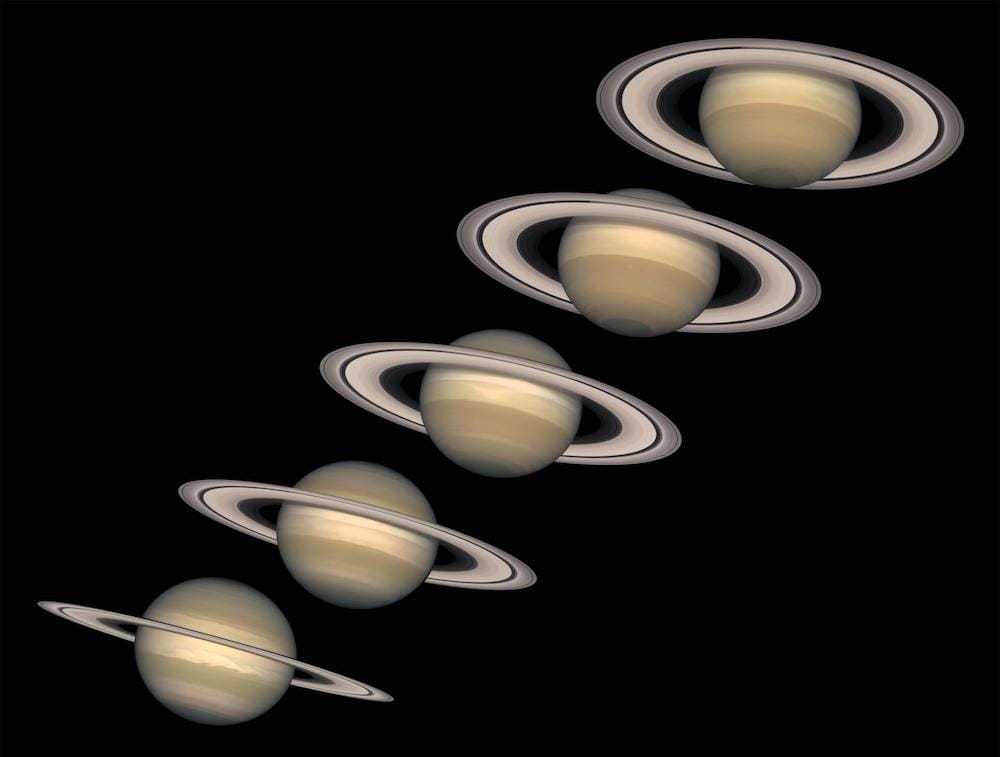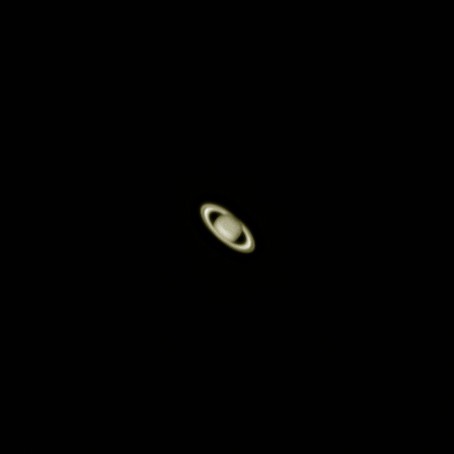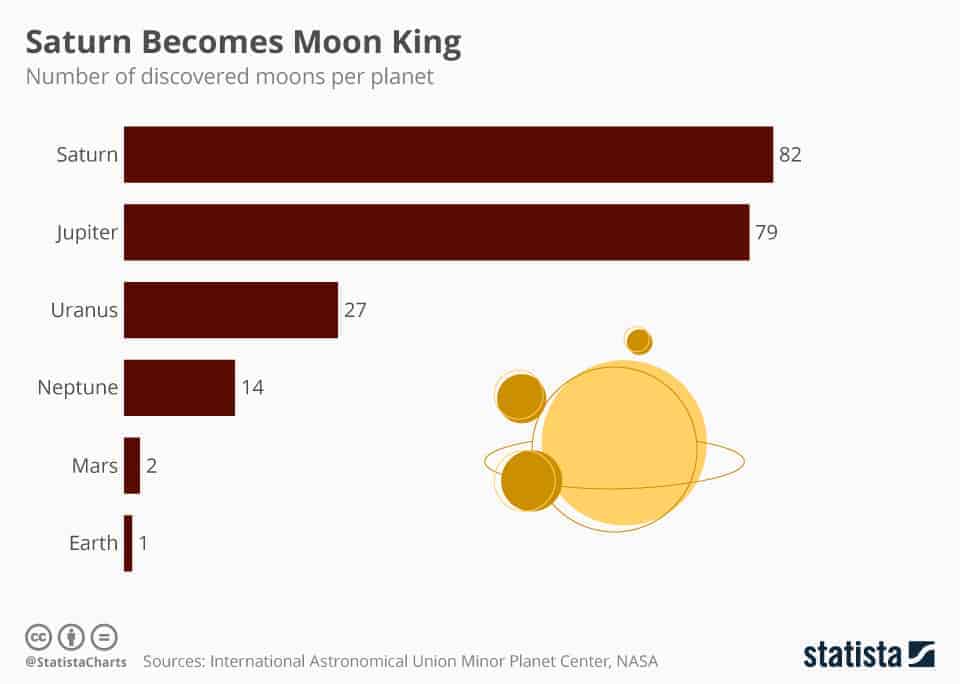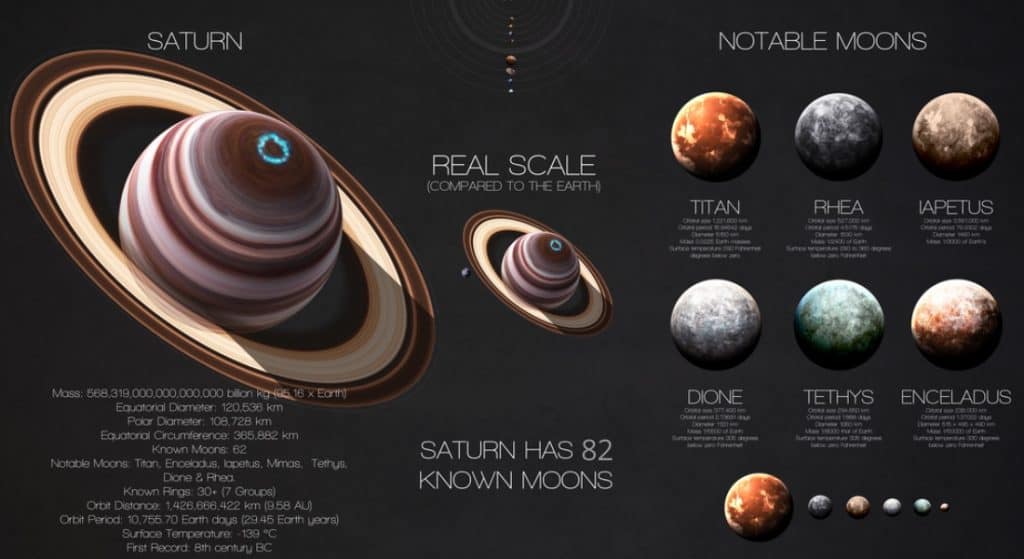Looking for an opportunity to get a good look at Saturn’s rings through a backyard view? What about just a good set of astronomy binoculars? Let’s investigate…Saturn through a telescope. Can you see Saturn’s ring with binoculars or must you have a telescope, and if so, what type?
When best to see Saturn and its rings
Your best chance of seeing good views of Saturn is when it is “in opposition.” As explained in our article on how to observe Jupiter, in opposition is when the three objects, in this case, Saturn, the Earth, and the sun, align, but more to the point, Earth is between Saturn and the Sun, hence why it is called in opposition.
The closer you are to this point, the easier it is to see Saturn, which is closer to and in alignment with the Earth as opposed to elsewhere in its orbit, at this time.
In 2020, this will be on 20 July. The next three Saturn oppositions will occur in August in each of the years: 2021, 2022, and 2023.
Christmas star
Saturn with Jupiter in conjunction (0.1º degree) is a spectacular sight and occurs on the solstice night sky of 21 December 2020, people refer to it as the Christmas Star. This great conjunction is a rare sight in viewing Saturn and Jupiter from Earth, one that has not been seen for hundreds of years.
This is the best time to see these two gas giants together in a single field of view. Jupiter of course is the brightest of the two, with Saturn in a tilted position beside it and if you have the right magnification, you should see the major moons of Jupiter.
You’ll see this low in the west at dusk.
Titling of Saturn’s rings
The best time to be viewing planets is on a night without Moon illumination, particularly during clear conditions. And when the rings of Saturn are tilted somewhat…
The rings of Saturn when “tilted” provide a better showing.

A series of Hubble Space Telescope images from 1996 to 2000 show Saturn’s rings opening up when viewed from Earth. This happens as Saturn moves towards winter in its northern hemisphere. Like us, Saturn is tilted in its rotation around the Sun and thus, has seasons.
Because Saturn takes much longer to travel around the Sun, seeing the rings edge-on from Earth happens only every 15 years, approximately. The next time should be in 2025, the previous 2010. Hence when in opposition next (July 20), the rings should be observable.
Earthlings cannot see Saturn’s rings when the rings are edge-on as viewed from the Earth
~ NASA
You might like to join night sky parties and make it a social event. On NASA’s Night Sky Network, you’ll find the many clubs in the US where you can investigate this.
Saturn through binoculars?
With binoculars…
You might think this tricky, given how far away Saturn is (roughly 843.33 million miles, if you’re curious). How to see Saturn? One of the natural questions interested people ask are – “Can I see Saturn with binoculars?”
The best thing about using binoculars is, of course, that they are inexpensive. Telescopes don’t have to cost a fortune, but the best ones – and certainly those that would give you the best chance of seeing Saturn’s rings from home or even out in the country – don’t come cheap.
With a good set of binoculars, you can expect to Saturn, which has a mean apparent magnitude of +0.46. You may get a peak at Saturn’s largest moon, Titan, when its magnitude is at its max of +8.10 — the binocular limit is roughly +9.
Binoculars are easy to use. If you have ever used a telescope for astronomy before, you know how difficult it can be to maneuver and point it to get in the proper position to observe the target sky object (unless it’s the Moon). What’s more, you have to ensure that the sensitive lens, mirrors, and internal workings remain in good condition.
Binoculars are extremely mobile. With a telescope, you need to mount it in position and make sure that everything is in perfect balance. There are no such problems with binoculars, and you certainly don’t require a tripod to keep everything balanced.
How many rings does Saturn have?
Saturn has 7 rings (per NASA).
These rings are ice types, unlike the dust ones of Jupiter. They comprise mostly ice and rocks, the crushed debris of countless celestial bodies that have entered and been destroyed on entry to Saturn’s orbit due to immense pressure from the planet’s huge gravitational force. The size of the particles in the rings ranges from dust-sized icy bits to chunks the size of a house.
These rings are enormous in extent and bright. The two brightest can be depicted from backyard telescopes.
Re the oh-so-famous rings…
Galileo was the first to see them back in 1610, though with his weaker telescope, it looked more like they were attached. It was the Dutch astronomer Christiaan Huygens in 1655 who first proposed that they were individualized flat rings.
The remnants of former moons, asteroids, comets, ice features, and other celestial bodies all form different layers of different rings, hence the different colors.
The largest ring is 7,000 times the size of the planet itself. Overall, the rings are relatively thin, typically only around 9 m thick, though some formations within them can reach up to two miles high.
More mundane than the mythological naming system used to name the planets and moons themselves, Saturn’s main rings are simply named (from innermost to outermost) C, B, and A. Another is D, which is closest to the planet, but incredibly faint.
Needless to say, when you try to see Saturn with binoculars, you won’t see D.
But can you see any rings or Saturn itself with binoculars?
Can you see Saturn’s rings with binoculars?
You probably won’t see the rings of Saturn other than as bulges, when viewing through binoculars.
Are the rings of Saturn visible at all?
Saturn’s rings aren’t visible to the naked eye. You will see them through any telescope with a 30x or more magnification.
Are they visible through binoculars? The typical binoculars are 7x or 8x magnification and through these, you’ll pick up the rings as bulges (or handles) that give Saturn an oval disc shape.
Don’t expect to distinguish the rings of Saturn as separate from the planet itself through these everyday binoculars.
What does Saturn look like through binoculars?
Through the right binoculars, you should be able to pick out Saturn’s rich golden color and bulges at the sides, which are what you’ll make of the rings. You’ll see the bulges more so when the rings are open to us on Earth (as depicted by the above image).
While you can always try, you probably won’t see its rings separately, Saturn’s most attractive feature, with typical home binoculars, as they will probably not be powerful enough.
Tip: With all binoculars, the trick is keeping them steady. The larger the binoculars, the trickier this is. For best results when using binoculars, stabilize them on a tripod or other means.
With typical binoculars, Saturn will appear just like a bright star. Even a pair of 10×50 binoculars may not give you views good enough to see more than that.
A good set of astronomy binoculars with high power may be a different story. We’re looking at 20×60 or higher to discern the rings beyond being “handles” of Saturn. But as I mentioned above, the problem with handheld observation is the issue of vibration.
Viewing Saturn through telescope
The good news here is that Saturn is a big enough feature in our night sky that you can easily pick it from the rest. If you can’t, make use of star charts, get to know where it is in the Northern or Southern Hemisphere (according to your location), and find an appropriately dark and elevated location.
See also: What Does Venus Look Like Through a Telescope
Tip: When stargazing, no matter how keen you are, always allow your eyes to adjust to fully dark-adapted for at least half an hour before you intend to look. If you do need to use a light, make sure it has a red lens or is covered with an opaque red wrapping.
You’ll want to make sure that Saturn is visible “in the sky” the night you plan to observe. As you probably know, it may be visible in some months and not others. A useful page, timeanddate.com, tells you what planets are visible on a given night and the time expected at your particular location.
Once you have your telescope set up in a reasonably dark location, look through the telescope’s finder scope and locate the planet in the center of the view. Then, starting with low magnification (larger eyepiece focal length) locate and focus your eyepiece to see the planet.
Tip: If you wear glasses, it’s better to use eyepieces that allow for that so you can comfortably look through the eyepiece (and you’ll get a better experience). I cover this in my article on using telescopes with glasses.
Once you’ve got the planet lined up, you can scale-up in magnification (smaller eyepiece focal length). Just take note that the planet will move in the view as the Earth rotates and you will need to continually adjust the scope to continue seeing it. When scaling up, the field of view will be narrower, and with the object moving in the view, it can take practice to find the target object again. That’s of course unless you have a telescope and mount that automatically tracks the object in the night sky.
For a good telescope for viewing planets check out my guide including reviews of some popular types as well as the Dobsonian 6″ or 8″ reflector. If you want to know the difference between a refractor and a reflector telescope, see my article comparing the two.

What magnification do I need to see the rings of Saturn?
According to veteran observer Alan MacRobert at SkyandTelescope.com…
Saturn’s rings should be visible in even the smallest telescope at a magnification of 25 times. A good 3-inch scope at 50x magnification will show the rings as distinctly separate from the ball of the planet.
Another veteran observer, Terence Dickinson, says that the rings are visible with any telescope that has a magnification of 30x or more. You could use a nature spotting scope also.
But, keep in mind, that the quality of the optics, the dust in the atmosphere, the optical coatings, and the filters you use will affect what you see.
Working out magnification and eyepiece size
I cover how to work out magnifications and eyepiece sizes for planet viewing in more depth in my article on the best eyepieces to use.
Saturn’s moons
The influence of Roman mythology is seen in the naming of Saturn’s moons, of which there are 82 at the time of writing (per NASA).

The largest of Saturn’s moons is named, appropriately enough, Titan.
Largest body of liquid on Titan
Kraken Mare is Titan’s largest known body of liquid.

More Saturn Facts
Saturn is the slowest of the Solar System planets that can be seen by the unaided eye. It takes 29 ½ years to orbit the Sun. It shares itself among the constellations of the zodiac, spending about two months in each.
Saturn, like the other outer planets of the solar system, is a gas giant. Its volume is greater than that of 760 Earths.
While that’s good enough to make Saturn the second-largest planet next to Jupiter (appropriate if you remember the Jupiter/Zeus Cronos/Saturn connection), Saturn is the least dense of all the planets in the solar system, and the only one that is actually less dense than water molecules.
Saturn’s surface is “ringed” with incredibly fast winds that can reach as high as 1,100 mph. Heat rises from the interior of the gas giant as well. The planet rotates quicker than Earth, completing a rotation once every 10.5 Earth hours. This fast rotation also means the center of the planet bulges.
Final thoughts
Saturn is by far one of the most interesting features in our solar system, and can be seen with binoculars. To see its mighty rings you need the right magnification. However, it is well worth the cost, as those rings and the planet itself represent a truly titanic force in our stargazing imaginations.
If you’re new here and starting out with astronomy, be sure to check out our Beginner’s Page where you will find helpful guides and tips to get more out of your stargazing experience.
Or, see our Buyer’s Guide Section if you are looking to buy astronomy gear and need some help sorting through the numerous options.
Info sources
- NASA: Saturn’s Moons
- NASA: Saturn Facts
- Dickinson, Terence. 2019. NightWatch. A Practical Guide to Viewing the Universe. (affiliate link) Firefly. New York.
